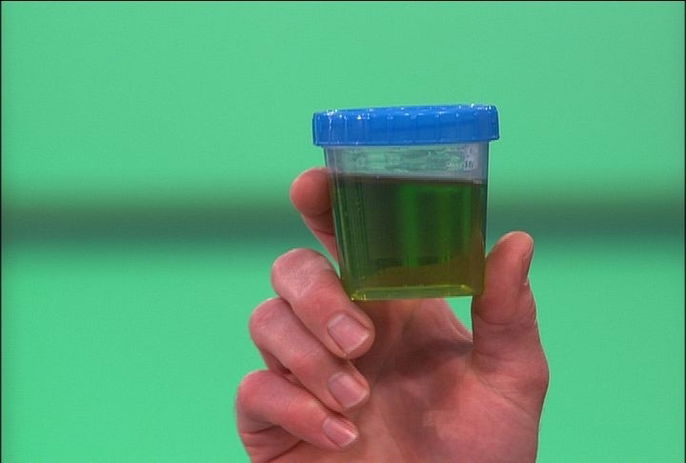Green urine usually occurs as a result of eating green foods or foods with artificial dyes. It can also occur after taking medications or using contrast to perform imaging tests, like a CT scan. In these cases, green urine is not dangerous and is not considered to be a serious finding.
However, green urine can also occur due to a UTI caused by Pseudomonas sp. bacteria. Green urine from an infection will also be accompanied by symptoms like fever, pain, burning when urinating and a feeling of heavy bladder.
Therefore, if the urine remains green for more than 2 days, it is advisable to proceed to the emergency room or see your doctor for assessment and treatment as necessary. Be sure to disclose any medications or supplements you are taking to your doctor.

Why is my urine green?
Green urine is commonly caused by:
1. Medication use
Medications are the most common reason for green urine, particularly those that are made with dyes or other artificial colors. The most common medications to cause green urine include amitriptyline, indomethacin and methocarbamol.
Green urine can also emerge following surgery, as some components of general anesthetic, like propofol, can alter urine color.
What to do: No further treatment is necessary, as the urine color in this case will not affect overall body functioning. You should still notify your prescriber of the side effect, however, to see whether a dose change or alternative medication is needed.
2. Eating asparagus or other foods
Some foods can give urine a green color, particularly those with artificial coloring like cakes or gummy candy. Leafy green vegetables, like spinach or asparagus, have high levels of chlorophyll, which can also make urine green.
Urine color can vary from a light to a dark green, depending on the amount of food eaten.
What to do: If you ate any of these foods and noticed a change to your urine color, you should not worry. Urine color will usually return to normal within a day.
3. UTI
Although most UTIs do not cause any urine color changes, there are some bacteria that can make your urine appear green. Infections caused by Pseudomonas aeruginosa bacteria, for example, are associated with green urine and are commonly found in patients admitted in a hospital.
In addition to green urine, infected patients may also notice other UTI symptoms, like fever and bladder heaviness. Read more about UTI symptoms to look out for, and complete out online symptom checker to assess your risk for a UTI.
What to do: If you suspect you have a UTI, you should see your doctor for a urine test and to assess the need to initiate antibiotic treatment. UTI treatment can vary depending on your symptoms and the underlying bacteria causing infection.
4. Image tests with contrast dye
Some medical tests that use contrast like blue methylene can turn change urine color and make it green. Depending on the type of contrast used, other colors may also be noticed, like blue, red or pink.
What to do: Specific treatment is not necessary, however you should drink plenty of fluid to help eliminate any lingering contrast quickly.
When to see a doctor
If your urine is green for over 2 days, you should seek medical attention for assessment, diagnosis and treatment as appropriate. You should take a list of your medications with you, so that the doctor can rule out whether the green urine is a result of a specific medication.






























